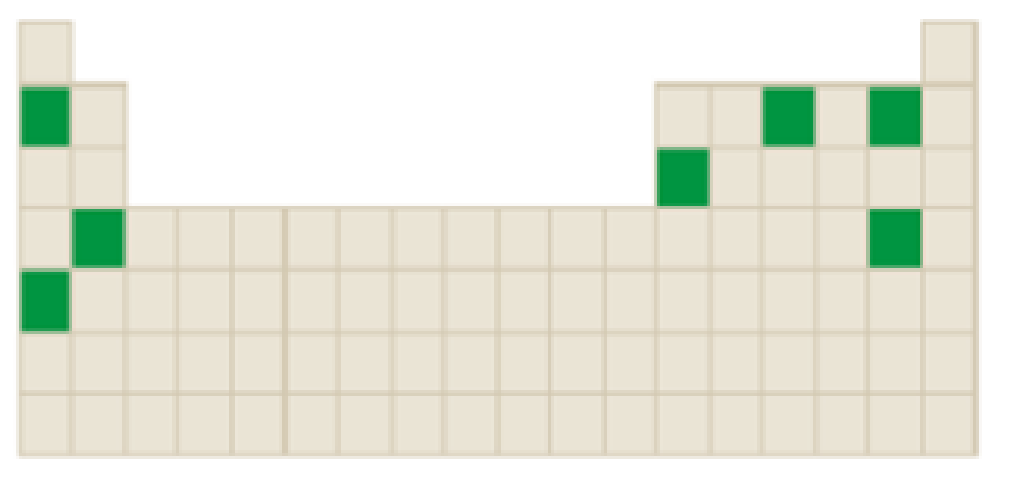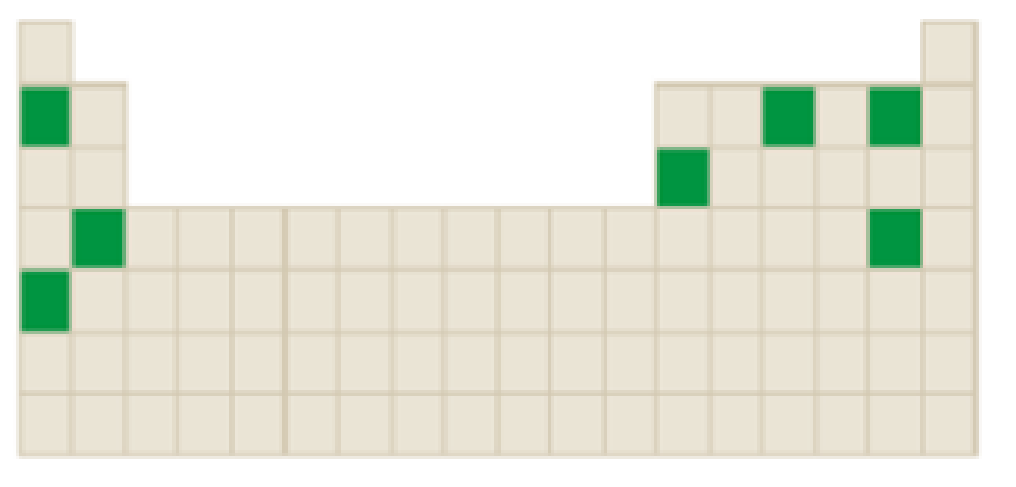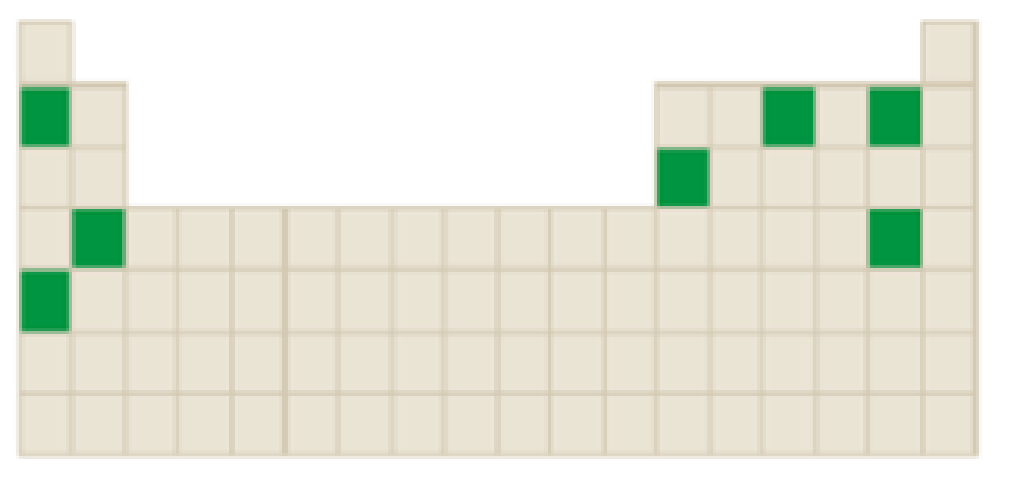
(a)
Interpretation:
Identification of the number of elements forms a positively charged ions among the following highlighted elements in the below periodic table:

Concept Introduction:
Atoms tend to gain or lose electrons until they obtain an electron configuration that is the same as that of a noble gas.
The neutral atom has equal number of protons and electrons. Gaining or loosing of a electrons of an atoms form ions.
Atoms form their ions to attain noble gas configuration.
- Group IA, IIA and IIIA are metal atoms containing one, two or three valence electrons. These metal atoms lose their valence electrons to get noble gas configuration.
- Group VA, VIA VIIA are non-metal atoms containing five, six or seven valence electrons. These non-metal atoms acquire electrons to get noble gas configuration.
- Group IVA group elements have four valence electrons. These elements either gain or lose their electrons to get noble gas configuration.
(b)
Interpretation:
Identification of the element forms ions through loss of electrons among the following highlighted elements in the below periodic table:

Concept Introduction:
Atoms tend to gain or lose electrons until they obtain an electron configuration that is the same as that of a noble gas.
The neutral atom has equal number of protons and electrons. Gaining or loosing of a electrons of an atoms form ions.
Atoms form their ions to attain noble gas configuration.
- Group IA, IIA and IIIA are metal atoms containing one, two or three valence electrons. These metal atoms lose their valence electrons to get noble gas configuration.
- Group VA, VIA VIIA are non-metal atoms containing five, six or seven valence electrons. These non-metal atoms acquire electrons to get noble gas configuration.
- Group IVA group elements have four valence electrons. These elements either gain or lose their electrons to get noble gas configuration.
(c)
Interpretation:
Identification of the elements which forms ion that has a charge magnitude of

Concept Introduction:
Atoms tend to gain or lose electrons until they obtain an electron configuration that is the same as that of a noble gas.
The neutral atom has equal number of protons and electrons. Gaining or loosing of a electrons of an atoms form ions.
Atoms form their ions to attain noble gas configuration.
- Group IA, IIA and IIIA are metal atoms containing one, two or three valence electrons. These metal atoms lose their valence electrons to get noble gas configuration.
- Group VA, VIA VIIA are non-metal atoms containing five, six or seven valence electrons. These non-metal atoms acquire electrons to get noble gas configuration.
- Group IVA group elements have four valence electrons. These elements either gain or lose their electrons to get noble gas configuration.
(d)
Interpretation:
Identification of the element forms an ion that involves gain of two or more electrons among the following highlighted elements in the below periodic table:

Concept Introduction:
Atoms tend to gain or lose electrons until they obtain an electron configuration that is the same as that of a noble gas.
The neutral atom has equal number of protons and electrons. Gaining or loosing of a electrons of an atoms form ions.
Atoms form their ions to attain noble gas configuration.
- Group IA, IIA and IIIA are metal atoms containing one, two or three valence electrons. These metal atoms lose their valence electrons to get noble gas configuration.
- Group VA, VIA VIIA are non-metal atoms containing five, six or seven valence electrons. These non-metal atoms acquire electrons to get noble gas configuration.
- Group IVA group elements have four valence electrons. These elements either gain or lose their electrons to get noble gas configuration.
Want to see the full answer?
Check out a sample textbook solution
Chapter 4 Solutions
General, Organic, and Biological Chemistry
- QUESTION: Fill out the answers to the empty green boxes attached in the image. *Ensure you all incorporate all 27 values (per column)*arrow_forwardYou need to make a buffer by dissolving benzoic acid and sodium benzoate in water. What is the mass of benzoic acid that you would weigh out, in mg, to create 50 mL of a buffer at pH = 4.7 that will change pH no more than 0.10 units with the addition of 0.001 moles of acid or base? Enter just the answer without the units (mg) - just the number will do!arrow_forwardDraw the formula for 3-isopropylcyclopentane-1-carbonyl chloride.arrow_forward
- QUESTION: Fill out the answers to the empty green boxes attached in the image. *Ensure you all incorporate all 27 values (per column)*arrow_forwardComplete the following reactions- hand written pleasearrow_forwardGive the organic product: O A O B Ос ○ D -NH–CH3 + CH3 CH3 NEN C ? A CH3 CH3 NH- CH3 B CH3 CH3 N=N- C CH3 CH3 N=NNH CH3 D CH3 N=N CH3 NHCH3 LNH CHOarrow_forward
- Finish the reaction- hand written pleasearrow_forwardGive the organic products: (benzyne) Br ? CH3 + K* :NH, liq NH3 HINT: Two products are formed. Each is a substituted aniline; they are isomers of each other. NH2 II I H₂N. CH3 CH3 III Select one: ○ A. I and II ○ B. I and III O C. I and IV O D. II and III O E. III and IV H₂N CH3 IV CH₂-NH2arrow_forwardPredict the major products of this organic reaction: HBr (1 equiv) cold ? Some important notes: • Draw the major product, or products, of this reaction in the drawing area below. • You can draw the products in any arrangement you like. • Pay careful attention to the reaction conditions, and only include the major products. • Be sure to use wedge and dash bonds when necessary, for example to distinguish between major products that are enantiomers. • Note that there is only 1 equivalent of HBr reactant, so you need not consider the case of multiple additions. Erase something Explanation Check 2025 McGraw Hill LLC. All Rights Reserved. Terarrow_forward
- Q14. Fill this chart: (please refer to ppt notes/browser to answer these questions) What alcohol is also called wood alcohol? What is the common name of ethanol? Draw the structure of phenol and thiophene? Are bigger chain alcohol like heptanol and octanol are soluble or insoluble in water and explain it ? Are ethers soluble or insoluble in water? What suffix and prefix are used for alcohol while naming alcohol and ether? What the process called when we add water to any alkene to make alcohol? Q16. Draw the diagram of following aromatic compound (practice from previous module) Aniline Phenol Benzoic acid Methyl benzoate Q17. a. Write the oxidation reactions for the 2 propanol. b. Write the oxidation reaction of the ethanol.arrow_forwardQuestion 11 of 18 (1 point) Question Attempt: 3 of How many signals do you expect in the 'H NMR spectrum for this molecule? Br Br Write the answer below. Also, in each of the drawing areas below is a copy of the molecule, with Hs shown. In each copy, one of the H atoms is colored red. Highlight in red all other H atoms that would contribute to the same signal as the H already highlighted red. Note for advanced students: In this question, any multiplet is counted as one signal. Number of signals in the 'H NMR spectrum. 1 For the molecule in the top drawing area, highlight in red any other H atoms that will contribute to the same signal as the H atom already highlighted red. If no other H atoms will contribute, check the box at right. No additional Hs to color in top molecule Check For the molecule in the bottom drawing area, highlight in red any other H atoms that will contribute to the same signal as the H atom already highlighted red. If no other H atoms will contribute, check the box…arrow_forwardOrganic Chemistry Esterification reactions 1. Write the steps to prepare ester. 2. Write complete reaction of ethanol and acetic acid to make ester. 3. What does ester smell like? What are the uses of ester. 4. What the role of sulfuric acid in the esterification reactionarrow_forward
 World of Chemistry, 3rd editionChemistryISBN:9781133109655Author:Steven S. Zumdahl, Susan L. Zumdahl, Donald J. DeCostePublisher:Brooks / Cole / Cengage Learning
World of Chemistry, 3rd editionChemistryISBN:9781133109655Author:Steven S. Zumdahl, Susan L. Zumdahl, Donald J. DeCostePublisher:Brooks / Cole / Cengage Learning Introductory Chemistry: A FoundationChemistryISBN:9781337399425Author:Steven S. Zumdahl, Donald J. DeCostePublisher:Cengage Learning
Introductory Chemistry: A FoundationChemistryISBN:9781337399425Author:Steven S. Zumdahl, Donald J. DeCostePublisher:Cengage Learning General, Organic, and Biological ChemistryChemistryISBN:9781285853918Author:H. Stephen StokerPublisher:Cengage Learning
General, Organic, and Biological ChemistryChemistryISBN:9781285853918Author:H. Stephen StokerPublisher:Cengage Learning
 Chemistry for Today: General, Organic, and Bioche...ChemistryISBN:9781305960060Author:Spencer L. Seager, Michael R. Slabaugh, Maren S. HansenPublisher:Cengage Learning
Chemistry for Today: General, Organic, and Bioche...ChemistryISBN:9781305960060Author:Spencer L. Seager, Michael R. Slabaugh, Maren S. HansenPublisher:Cengage Learning Introductory Chemistry: An Active Learning Approa...ChemistryISBN:9781305079250Author:Mark S. Cracolice, Ed PetersPublisher:Cengage Learning
Introductory Chemistry: An Active Learning Approa...ChemistryISBN:9781305079250Author:Mark S. Cracolice, Ed PetersPublisher:Cengage Learning





